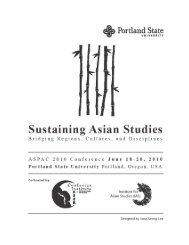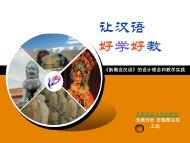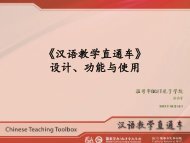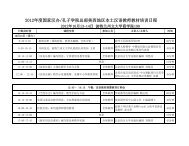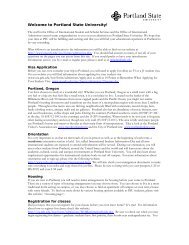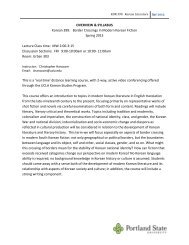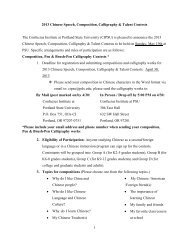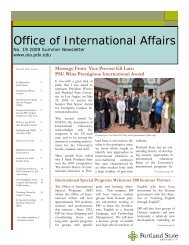ABSTRACTS - oia - Portland State University
ABSTRACTS - oia - Portland State University
ABSTRACTS - oia - Portland State University
You also want an ePaper? Increase the reach of your titles
YUMPU automatically turns print PDFs into web optimized ePapers that Google loves.
ASPAC Conference 2010<br />
June 18 – 20, 2010 | <strong>Portland</strong>, OR<br />
Aekyoung KIM<br />
A Study of the Religious Features in Ukiyo-e: Focus on Hiroshige's Meisho Edo Hyakkei<br />
Customs are a part of a living culture which reflect the times including religion, life, politics, and ideas. Thus<br />
a genre painting whose material deals with customs is closely related to human life. Ukiyo-e is a genre of<br />
Japanese woodblock prints and paintings and are among the most widely known and admired arts of the Edo<br />
period. Hiroshige (1797-1858) was one of the last great masters of the Ukiyo-e and earned his reputation<br />
with a series of views featuring the well-known sights of Japan. Even as he got older, Hiroshige's artwork was<br />
very popular. In 1856 he "retired from the world" to become a Buddhist monk. That same year he began<br />
work on his masterpiece Meisho Edo Hyakkei (One Hundred Famous Views of Edo) just before his death.<br />
Meisho Edo Hyakkei, actually composed of 118 splendid woodblock landscape and genre scenes<br />
depicting mid 19 th<br />
century Edo, is one of the greatest achievements of Japanese art. It is a work that inspired a<br />
number of Western artists including Vincent Van Gogh, to experiment with imitations of Japanese methods.<br />
Meisho is usually translated "famous places," or "celebrated sites". Hiroshige portrayed many Buddhist temples<br />
and Shinto shrines and religious images from various angles. Religion harmonized with the lives of people in<br />
his works. The object of this study is to understand the role of religion at the end of the shogunate era<br />
through Hiroshige's artwork, and to discover why his work has been able to attract the attention of many<br />
different people over a long period of time.<br />
~ ~ ~ ~ ~ ~ ~ ~ ~ ~<br />
Sung Lim Kim<br />
Ch’aekkori: Still Life Painting of 19 th Century Korea<br />
19 th century Choson dynasty, especially in Seoul, changed dramatically from a traditional Confucian society to<br />
a society of commerce and material consumption. Ch’aekkori painting is the depiction of objects (still life)<br />
including books, stationary implements, luxurious imports, and symbolic and auspicious fruits and accessories,<br />
which reflected the new materialism. Believed to have originated from Chinese treasure walls in Qing<br />
Forbidden Palace, ch’aekkori painting was favored and promoted by King Chongjo (1786-1800), who used it<br />
to deliver his message of scholarly pursuit and to direct his officials toward proper reading material.<br />
Ch’aekkori was first painted by court painters, but it soon became popular and widespread among the elite<br />
yangban as well as commoners. The paper explores how ch’aekkori painting reflected Korea’s active cultural<br />
interactions with China, its own internal social and cultural evolution, and Koreans’ changing perceptions of<br />
material objects.<br />
~ ~ ~ ~ ~ ~ ~ ~ ~ ~<br />
Young-Cheol Kim<br />
The Green Sea of Dotonborigawa<br />
Born in Kobe in 1947, Miyamoto Teru won the 13 th Dazai Osamu Prize in 1977 for his story Doronogawar; in<br />
1978 he was awarded the 78 th Akutagawa Prize for Hotorugawa; and in 1981 he completed his Three Rivers<br />
trilogy with the publication of Dotonborigawa. These early works are based on the author’s experiences, but not<br />
to the extent that they would be called autobiographical. These stories depict the lives of people in the redlight<br />
district and feature two main characters; Takeuchi, a middle-aged man who runs a cafeteria in Dotonbori,<br />
and his part-time worker Kunihiko. Miyamoto describes the affair between the fortune teller Sugiyama and<br />
Takeuchi’s wife, Suzuko; he describes the relationship between Kunihiko and Hiromi who was his father’s<br />
mistress; and he shows us the lives of the dancer, Satomi and the profiligate, Kaoru. The sympathetic author<br />
wants his readers to share the joys sorrows as well as the dreams of these people living in the midst of the redlight<br />
district. A painting, “The Green Sea,” and a jade water pitcher, Giyaman, symbolize the dreams of these<br />
people struggling to survive in Dotonbori and hoping for a better future.<br />
Sugiyama’s painting, “The Green Sea,” reflects the hope that only be recognized by people who long<br />
for what is missing in reality. The fortuneteller Sugiyama can tell the future of others, but not his own as he<br />
19




